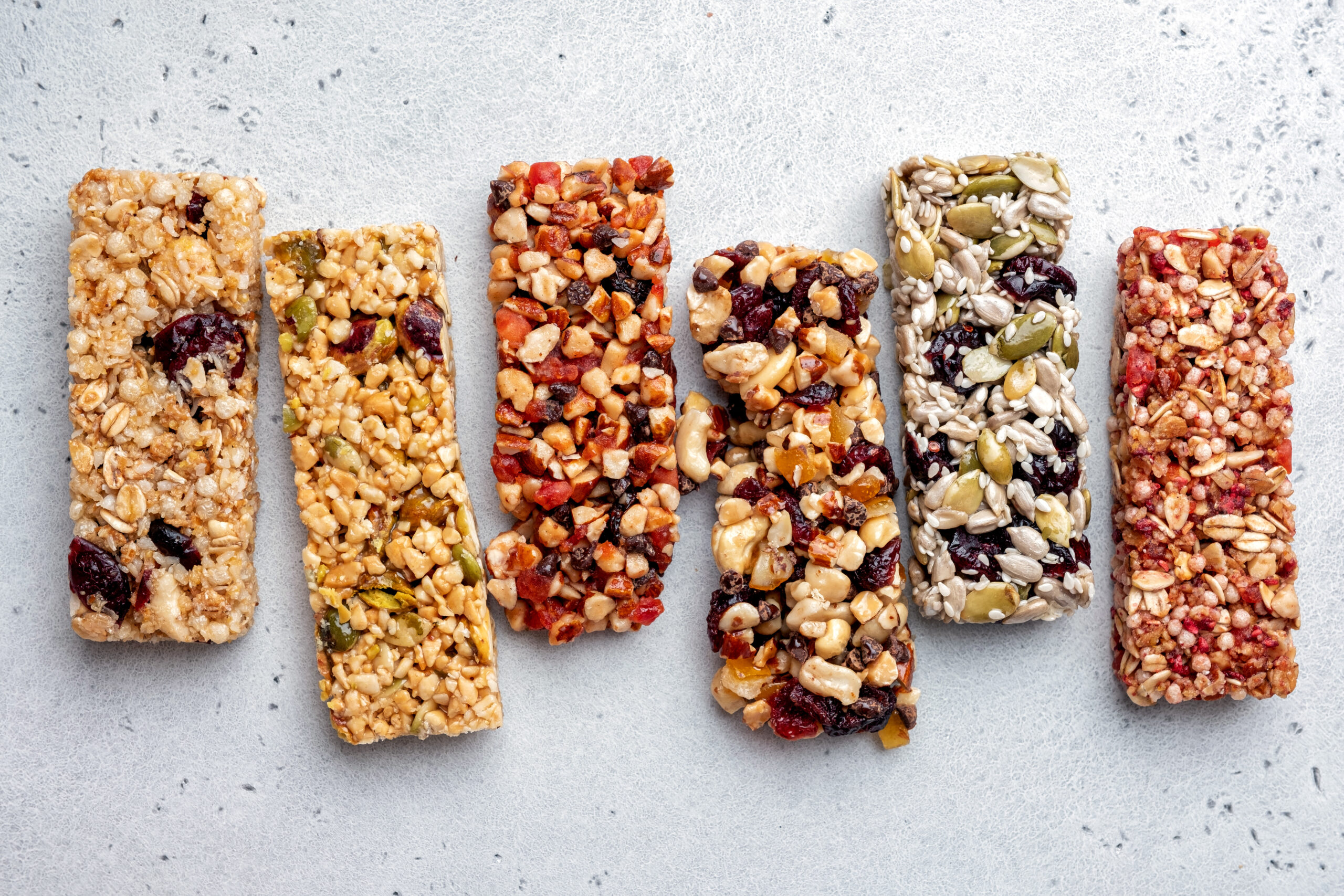
When you start to feel hungry throughout the day, you may be reach for a sweet or savory snack to satisfy those cravings.
According to the 2023 Food and Health Survey from the International Food Information Council (IFIC), 72% of Americans snack at least once a day, with the most common reasons for snacking related to hunger or thirst. (1)
Planning for nutritious snacks can help regulate blood sugar, leading to overall increased energy, concentration, and balanced hunger and fullness levels throughout the day.
Carbohydrates, protein, and fat are macronutrients that make up the largest amount of nutrients required in the diet, providing our body with energy (calories) and supporting the body’s structural function.
Here’s a brief breakdown of the three macronutrients:
Carbohydrates
The three types of carbohydrates are sugars, starches, and fiber. The body breaks down digestible carbohydrates (sugar and starches) into glucose (blood sugar) to be used as fuel for the body and is the brain’s most preferred energy source.
The two categories of carbohydrates are simple and complex carbohydrates. Simple carbohydrates, also known as sugars, are found naturally in fruits and fruit juices, and dairy products, and as refined sweeteners, such as table sugar and syrups. These sweeteners are often added to food and drinks, called ‘added sugars.’
The Dietary Guidelines for Americans recommends limiting added sugars to less than 10% of total calories per day. (2)
The naturally occurring sugars in whole fruits are accompanied by dietary fiber, vitamins, and minerals and do not contribute to the ‘added sugars’ category.
Complex carbohydrates include many plant foods, such as whole grains, legumes, and vegetables.
Dietary fiber is another form of complex carbohydrate and is unique in that it is nondigestible and plays an important role in promoting gut health, lowering blood cholesterol levels, blood sugar regulation, and contributing to overall satiety.
Choosing high-fiber carbohydrates, such as whole grains, fruits, vegetables, and legumes, can help slow blood sugar absorption, supporting steadier energy and satiety levels.
Protein
Proteins are made up of 20 building blocks called amino acids, 9 of which are essential and must be obtained from food. Protein serves many purposes, such as growth, repair, and maintenance throughout the body.
We can get all the protein we need from plant foods. The richest sources of plant proteins are legumes (beans, peas, lentils, and soyfoods). Other sources of plant proteins include whole grains, nuts, seeds, and vegetables.
Plant proteins are also attached to dietary fiber, vitamins, and minerals, lower in saturated fat, and are cholesterol-free, not only supporting feeling fuller for longer but also health promotion and high nutritional value.
Protein foods have been associated with increased satiety; therefore, combining fiber-rich plant protein, such as nut butter, bean dips, or other nuts and seeds with nutrient-dense carbohydrates, into vegan snacks can help with feeling fuller for longer.
Fat
Dietary fats provide our bodies with energy and help absorb fat-soluble vitamins D, E, K, and A.
Two main types of dietary fats include unsaturated fats (monounsaturated and polyunsaturated fats) and saturated fats. Unsaturated fats are primarily found in plant foods, such as avocados, olives, nuts, seeds, and plant oils.
Saturated fats are mostly found in animal foods, with the exception of coconut oil and palm kernel oil which consist mainly of saturated fats.
It’s recommended to reduce saturated fat as much as possible in the diet. The Dietary Guidelines for Americans recommends getting less than 10% of calories from saturated fat each day. (2)
Incorporating healthy plant-rich fats, such as nuts, seeds, and avocados, into vegan snacks can further help with increasing satiety and nutrient absorption.
Selecting Simple and Satisfying Vegan Snacks
When it comes to snacking in a vegan diet, a little planning can go a long way toward making healthful choices more often.
Pairing plant foods together to create a nutritious and nourishing snack doesn’t have to be time-consuming. For example, having fruits and vegetables cut up ahead of time and ready to go, along with hummus, nut butter, or guacamole, can make for a more substantial snack.
One way to make plant-rich snacking more feasible on-the-go is to choose a day during the week to prepare snacks, such as making a batch of granola bars or energy bites.
Other Sweet and Savory Vegan Snack Ideas:
- Build your own trail mix by combining nuts, seeds, and dried fruit, or even with dark chocolate and popcorn!
- Homemade granola bars
- Veggies with hummus and olives
- Whole grain crackers, or nut and seed crackers with bean dip, or nut butter
- Bean-based chips, or lightly salted, or ‘no salt added’ tortilla chips, with salsa or guacamole
- No bake energy bites
- Nut butter and dried dates or prunes
- Classic ‘ants on a log’ (celery with nut butter and dried fruit of choice)
- “Nice” cream (blended frozen bananas and other fruit, as desired)
- Roasted chickpeas or edamame
- Air-popped popcorn
- Chickpea puffs
- Low-sodium or ‘no added salt’ pretzels with hummus
- Fruit and nut bars
- Fresh, frozen, or canned fruit with dairy-free yogurt or topped with plant-based whipped topping
- Baked cinnamon apples
- Whole-grain cookies or muffins
- Whole-grain cereal with fortified plant milk
- Whole-grain toast with nut butter and jam
- Chickpea salad tortilla roll-ups
- Vegan deli slices with veggies and whole-grain or seed crackers
Mindful Munching
While what snacks we choose to eat most often is important for our general health and wellness, asking why and how we snack is also beneficial.
Many factors affect why and how we snack, such as boredom, eating while distracted, social occasions, and emotional eating.
Research shows that practicing mindful eating can help distinguish between physical and emotional hunger and may contribute to choosing healthier snack options or smaller portions.
We can gradually bring more mindfulness into our snacking, especially while enjoying fun vegan treats. Some ways we can start to practice mindful eating is by placing snack foods in a bowl or plate, limiting distractions as possible while eating, and eating more slowly to be more present with the tastes, textures, and smell of foods.
Before grabbing a snack, taking a moment to assess hunger levels can be helpful. Are we physically hungry? If so, how hungry are we feeling? Is it more related to boredom or stress? If so, is there another activity that can replace snacking at that time? Of course, deciding to continue with having a snack is an option!
Going too long without eating or skipping meals can also affect our eating habits and food choices, which is another reason why tuning into our natural hunger and fullness signals can be a practical tool.
Planning for snacks to be prepared in advance, especially during busier days, can help set us up for success by building a foundation of healthy habits and enriching our eating experience through simple and satisfying vegan snacks.
If you’re looking for nutritional guidance and support on your plant-based journey, please feel free to reach out to schedule a free 20-minute discovery call here!
References
(1) International Food Information Council. 2023 Food and Health Survey. (2023, May 23). https://foodinsight.org/2023-food-and-health-survey/
(2) Dietary Guidelines for Americans, 2020-2025 and Online materials | Dietary Guidelines for Americans. (n.d.). https://www.dietaryguidelines.gov/resources/2020-2025-dietary-guidelines-online-materials
Holesh, J. E. (2023, May 12). Physiology, carbohydrates. StatPearls – NCBI Bookshelf. https://www.ncbi.nlm.nih.gov/books/NBK459280/
Protein. (n.d.). The Nutrition Source. https://www.hsph.harvard.edu/nutritionsource/what-should-you-eat/protein/
Types of fat. (n.d.). The Nutrition Source. https://www.hsph.harvard.edu/nutritionsource/what-should-you-eat/fats-and-cholesterol/types-of-fat/
The science of snacking. (2021, February). The Nutrition Source. https://www.hsph.harvard.edu/nutritionsource/snacking/
Mindful eating. (2020, September). The Nutrition Source. https://www.hsph.harvard.edu/nutritionsource/mindful-eating/
Mangels, R., Messina, V., & Messina, M. (2021). The Dietitian’s Guide to Vegetarian Diets: Issues and Applications. Jones & Bartlett Learning.
Disclaimer: This blog post is provided for informational and educational purposes only and should never be relied upon in any way as medical or mental health advice. Always consult your physician or other qualified healthcare provider for any health-related questions and concerns or before implementing anything you may learn through this blog post.
(Please note that external links open in a new window)

